University of Roehampton: Academic Stress in Psychology Students
VerifiedAdded on 2023/01/09
|24
|5364
|88
Report
AI Summary
This report presents a qualitative study on academic stress among second-year psychology students. The research, conducted at the University of Roehampton, employed a phenomenological approach using unstructured interviews to explore students' experiences. The study aimed to understand the differences in academic stress between first and second-year students, focusing on workload, commitments, and coping strategies. Findings revealed that second-year students experienced increased stress due to higher workloads, balancing commitments, and the impact of grades on their final degree. Poor time management emerged as a primary challenge. The analysis, based on Worthen and McNeill's (1996) method, involved individual and group analysis of interview transcripts, identifying common themes and individual experiences. The study highlights the need for effective time management and coping strategies to mitigate academic stress among psychology students.
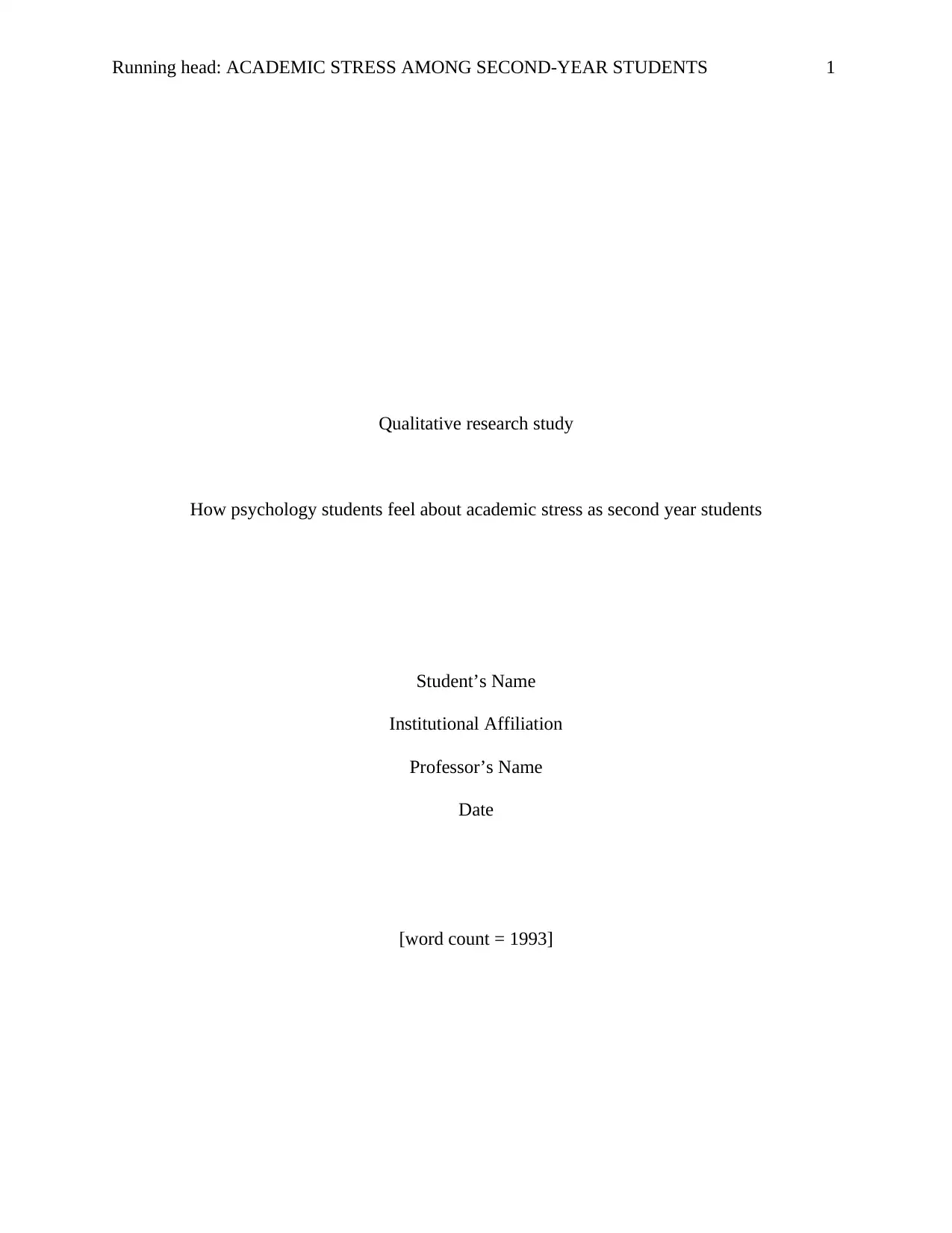
Running head: ACADEMIC STRESS AMONG SECOND-YEAR STUDENTS 1
Qualitative research study
How psychology students feel about academic stress as second year students
Student’s Name
Institutional Affiliation
Professor’s Name
Date
[word count = 1993]
Qualitative research study
How psychology students feel about academic stress as second year students
Student’s Name
Institutional Affiliation
Professor’s Name
Date
[word count = 1993]
Paraphrase This Document
Need a fresh take? Get an instant paraphrase of this document with our AI Paraphraser
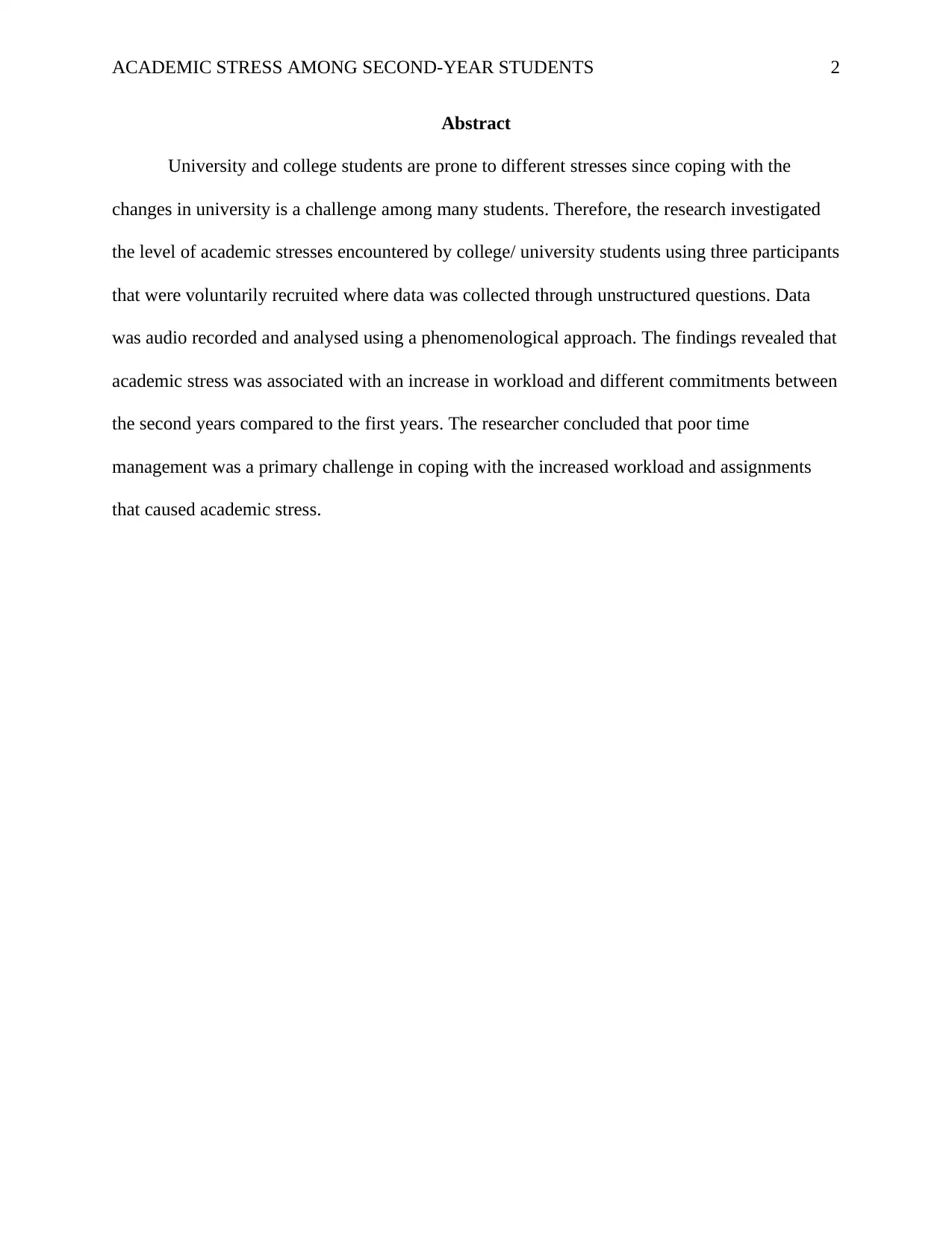
ACADEMIC STRESS AMONG SECOND-YEAR STUDENTS 2
Abstract
University and college students are prone to different stresses since coping with the
changes in university is a challenge among many students. Therefore, the research investigated
the level of academic stresses encountered by college/ university students using three participants
that were voluntarily recruited where data was collected through unstructured questions. Data
was audio recorded and analysed using a phenomenological approach. The findings revealed that
academic stress was associated with an increase in workload and different commitments between
the second years compared to the first years. The researcher concluded that poor time
management was a primary challenge in coping with the increased workload and assignments
that caused academic stress.
Abstract
University and college students are prone to different stresses since coping with the
changes in university is a challenge among many students. Therefore, the research investigated
the level of academic stresses encountered by college/ university students using three participants
that were voluntarily recruited where data was collected through unstructured questions. Data
was audio recorded and analysed using a phenomenological approach. The findings revealed that
academic stress was associated with an increase in workload and different commitments between
the second years compared to the first years. The researcher concluded that poor time
management was a primary challenge in coping with the increased workload and assignments
that caused academic stress.
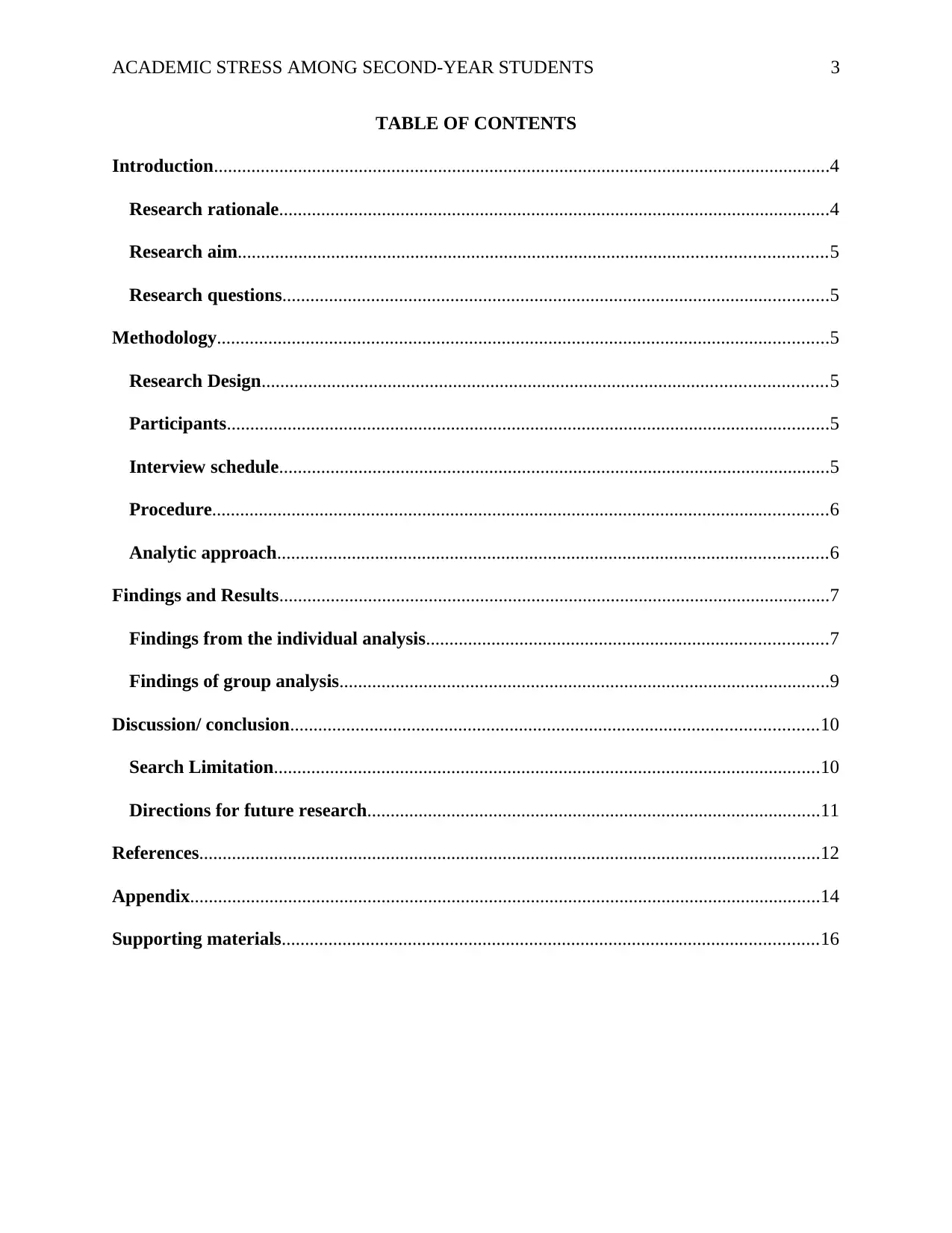
ACADEMIC STRESS AMONG SECOND-YEAR STUDENTS 3
TABLE OF CONTENTS
Introduction....................................................................................................................................4
Research rationale......................................................................................................................4
Research aim..............................................................................................................................5
Research questions.....................................................................................................................5
Methodology...................................................................................................................................5
Research Design.........................................................................................................................5
Participants.................................................................................................................................5
Interview schedule......................................................................................................................5
Procedure....................................................................................................................................6
Analytic approach......................................................................................................................6
Findings and Results......................................................................................................................7
Findings from the individual analysis......................................................................................7
Findings of group analysis.........................................................................................................9
Discussion/ conclusion.................................................................................................................10
Search Limitation.....................................................................................................................10
Directions for future research.................................................................................................11
References.....................................................................................................................................12
Appendix.......................................................................................................................................14
Supporting materials...................................................................................................................16
TABLE OF CONTENTS
Introduction....................................................................................................................................4
Research rationale......................................................................................................................4
Research aim..............................................................................................................................5
Research questions.....................................................................................................................5
Methodology...................................................................................................................................5
Research Design.........................................................................................................................5
Participants.................................................................................................................................5
Interview schedule......................................................................................................................5
Procedure....................................................................................................................................6
Analytic approach......................................................................................................................6
Findings and Results......................................................................................................................7
Findings from the individual analysis......................................................................................7
Findings of group analysis.........................................................................................................9
Discussion/ conclusion.................................................................................................................10
Search Limitation.....................................................................................................................10
Directions for future research.................................................................................................11
References.....................................................................................................................................12
Appendix.......................................................................................................................................14
Supporting materials...................................................................................................................16
⊘ This is a preview!⊘
Do you want full access?
Subscribe today to unlock all pages.

Trusted by 1+ million students worldwide
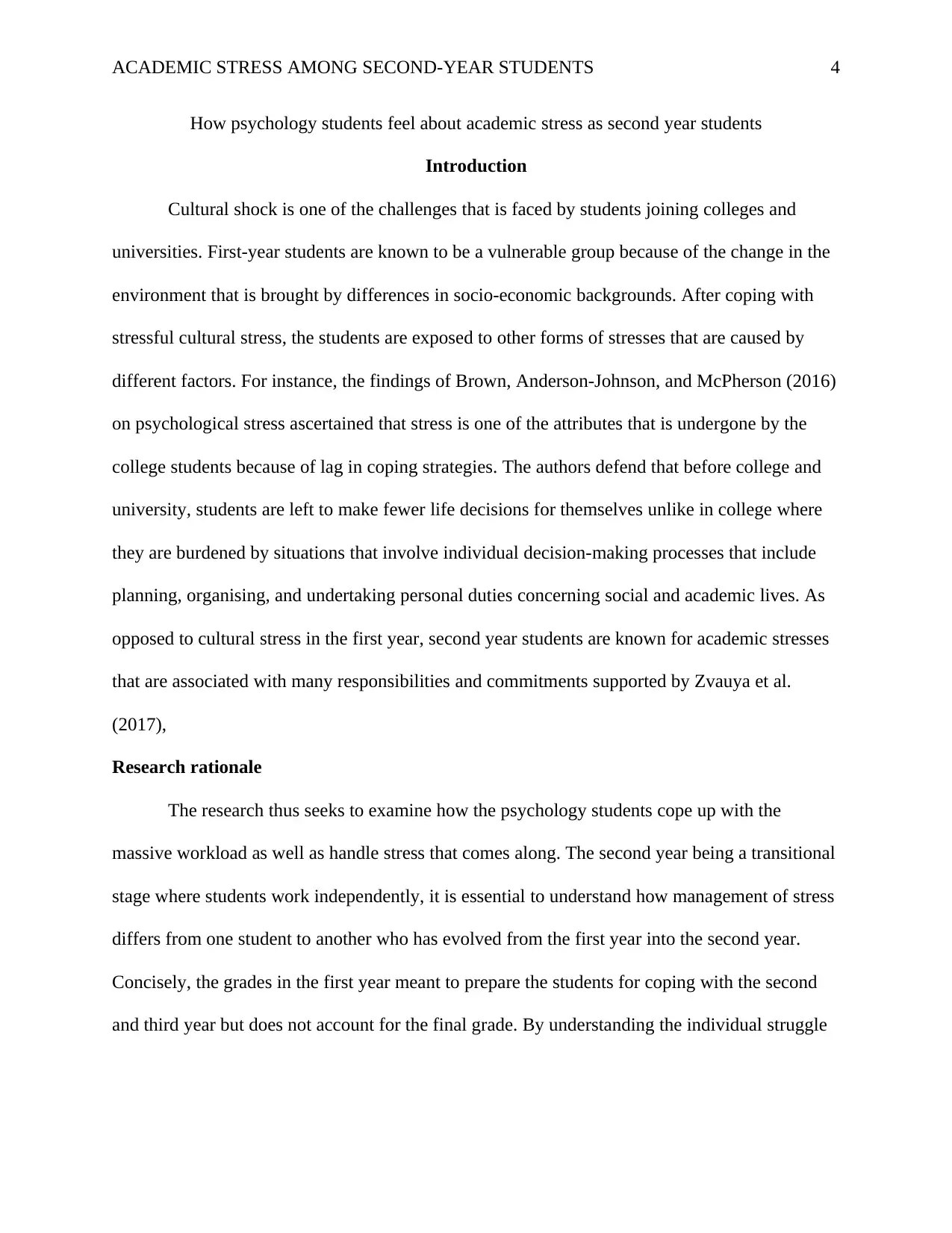
ACADEMIC STRESS AMONG SECOND-YEAR STUDENTS 4
How psychology students feel about academic stress as second year students
Introduction
Cultural shock is one of the challenges that is faced by students joining colleges and
universities. First-year students are known to be a vulnerable group because of the change in the
environment that is brought by differences in socio-economic backgrounds. After coping with
stressful cultural stress, the students are exposed to other forms of stresses that are caused by
different factors. For instance, the findings of Brown, Anderson-Johnson, and McPherson (2016)
on psychological stress ascertained that stress is one of the attributes that is undergone by the
college students because of lag in coping strategies. The authors defend that before college and
university, students are left to make fewer life decisions for themselves unlike in college where
they are burdened by situations that involve individual decision-making processes that include
planning, organising, and undertaking personal duties concerning social and academic lives. As
opposed to cultural stress in the first year, second year students are known for academic stresses
that are associated with many responsibilities and commitments supported by Zvauya et al.
(2017),
Research rationale
The research thus seeks to examine how the psychology students cope up with the
massive workload as well as handle stress that comes along. The second year being a transitional
stage where students work independently, it is essential to understand how management of stress
differs from one student to another who has evolved from the first year into the second year.
Concisely, the grades in the first year meant to prepare the students for coping with the second
and third year but does not account for the final grade. By understanding the individual struggle
How psychology students feel about academic stress as second year students
Introduction
Cultural shock is one of the challenges that is faced by students joining colleges and
universities. First-year students are known to be a vulnerable group because of the change in the
environment that is brought by differences in socio-economic backgrounds. After coping with
stressful cultural stress, the students are exposed to other forms of stresses that are caused by
different factors. For instance, the findings of Brown, Anderson-Johnson, and McPherson (2016)
on psychological stress ascertained that stress is one of the attributes that is undergone by the
college students because of lag in coping strategies. The authors defend that before college and
university, students are left to make fewer life decisions for themselves unlike in college where
they are burdened by situations that involve individual decision-making processes that include
planning, organising, and undertaking personal duties concerning social and academic lives. As
opposed to cultural stress in the first year, second year students are known for academic stresses
that are associated with many responsibilities and commitments supported by Zvauya et al.
(2017),
Research rationale
The research thus seeks to examine how the psychology students cope up with the
massive workload as well as handle stress that comes along. The second year being a transitional
stage where students work independently, it is essential to understand how management of stress
differs from one student to another who has evolved from the first year into the second year.
Concisely, the grades in the first year meant to prepare the students for coping with the second
and third year but does not account for the final grade. By understanding the individual struggle
Paraphrase This Document
Need a fresh take? Get an instant paraphrase of this document with our AI Paraphraser
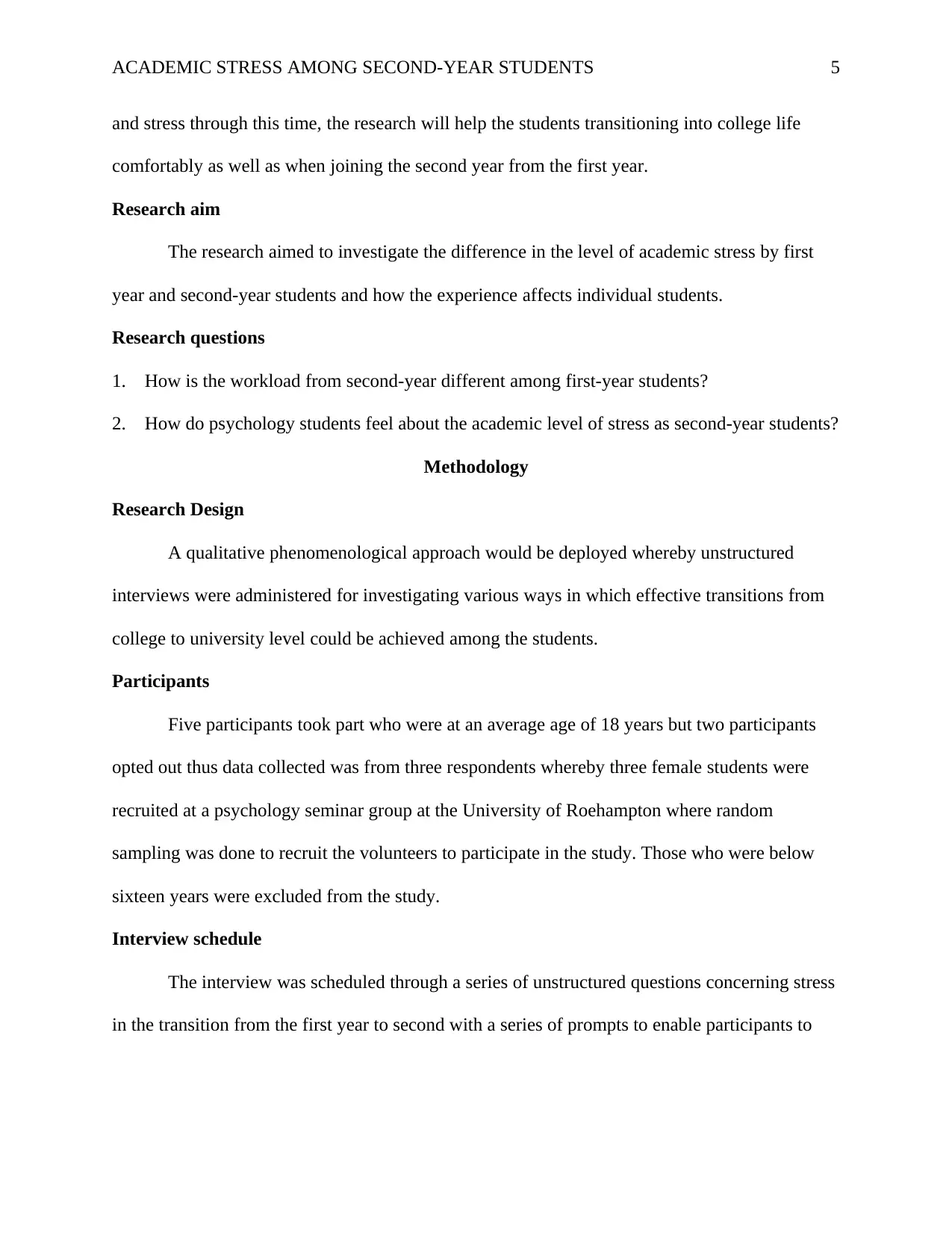
ACADEMIC STRESS AMONG SECOND-YEAR STUDENTS 5
and stress through this time, the research will help the students transitioning into college life
comfortably as well as when joining the second year from the first year.
Research aim
The research aimed to investigate the difference in the level of academic stress by first
year and second-year students and how the experience affects individual students.
Research questions
1. How is the workload from second-year different among first-year students?
2. How do psychology students feel about the academic level of stress as second-year students?
Methodology
Research Design
A qualitative phenomenological approach would be deployed whereby unstructured
interviews were administered for investigating various ways in which effective transitions from
college to university level could be achieved among the students.
Participants
Five participants took part who were at an average age of 18 years but two participants
opted out thus data collected was from three respondents whereby three female students were
recruited at a psychology seminar group at the University of Roehampton where random
sampling was done to recruit the volunteers to participate in the study. Those who were below
sixteen years were excluded from the study.
Interview schedule
The interview was scheduled through a series of unstructured questions concerning stress
in the transition from the first year to second with a series of prompts to enable participants to
and stress through this time, the research will help the students transitioning into college life
comfortably as well as when joining the second year from the first year.
Research aim
The research aimed to investigate the difference in the level of academic stress by first
year and second-year students and how the experience affects individual students.
Research questions
1. How is the workload from second-year different among first-year students?
2. How do psychology students feel about the academic level of stress as second-year students?
Methodology
Research Design
A qualitative phenomenological approach would be deployed whereby unstructured
interviews were administered for investigating various ways in which effective transitions from
college to university level could be achieved among the students.
Participants
Five participants took part who were at an average age of 18 years but two participants
opted out thus data collected was from three respondents whereby three female students were
recruited at a psychology seminar group at the University of Roehampton where random
sampling was done to recruit the volunteers to participate in the study. Those who were below
sixteen years were excluded from the study.
Interview schedule
The interview was scheduled through a series of unstructured questions concerning stress
in the transition from the first year to second with a series of prompts to enable participants to
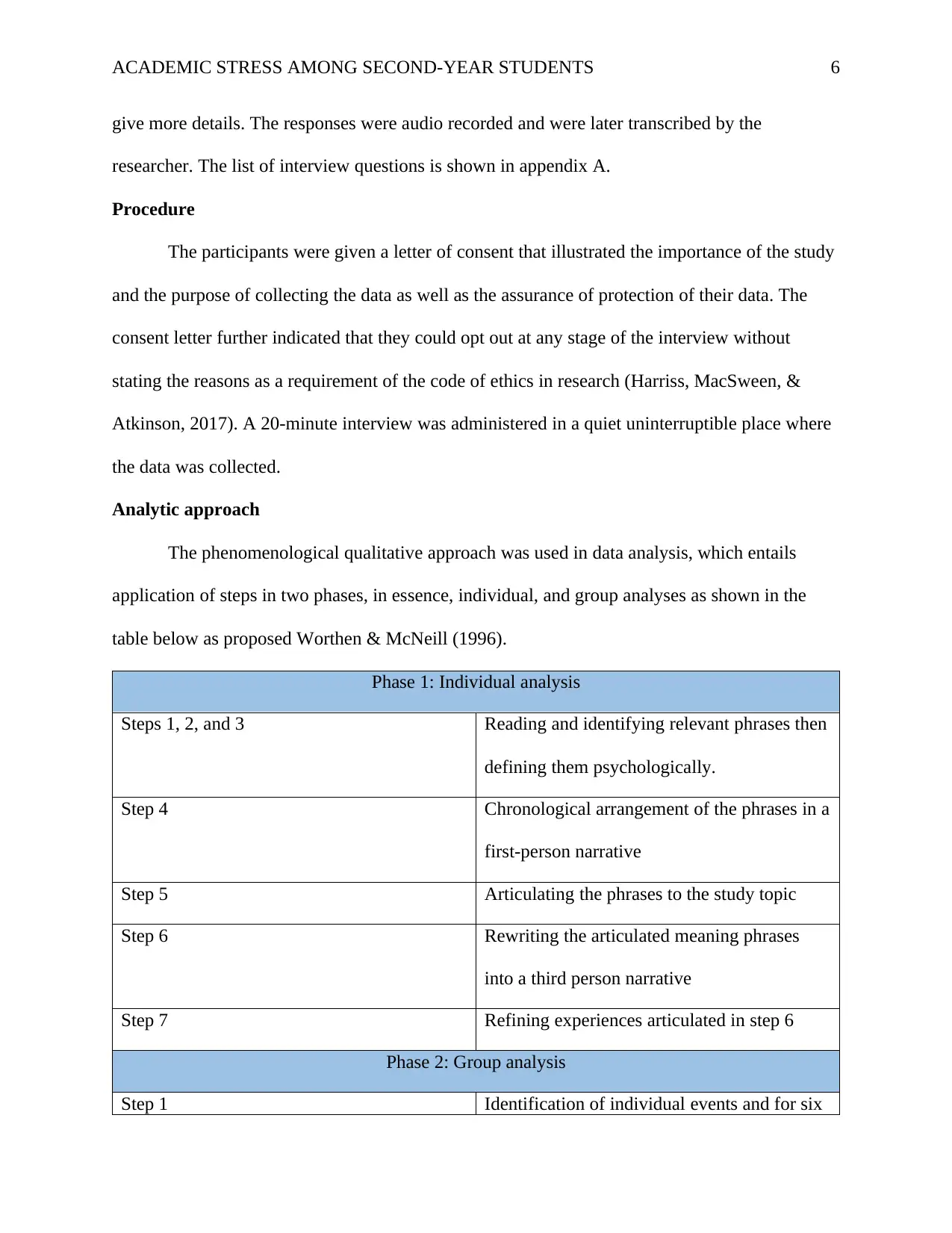
ACADEMIC STRESS AMONG SECOND-YEAR STUDENTS 6
give more details. The responses were audio recorded and were later transcribed by the
researcher. The list of interview questions is shown in appendix A.
Procedure
The participants were given a letter of consent that illustrated the importance of the study
and the purpose of collecting the data as well as the assurance of protection of their data. The
consent letter further indicated that they could opt out at any stage of the interview without
stating the reasons as a requirement of the code of ethics in research (Harriss, MacSween, &
Atkinson, 2017). A 20-minute interview was administered in a quiet uninterruptible place where
the data was collected.
Analytic approach
The phenomenological qualitative approach was used in data analysis, which entails
application of steps in two phases, in essence, individual, and group analyses as shown in the
table below as proposed Worthen & McNeill (1996).
Phase 1: Individual analysis
Steps 1, 2, and 3 Reading and identifying relevant phrases then
defining them psychologically.
Step 4 Chronological arrangement of the phrases in a
first-person narrative
Step 5 Articulating the phrases to the study topic
Step 6 Rewriting the articulated meaning phrases
into a third person narrative
Step 7 Refining experiences articulated in step 6
Phase 2: Group analysis
Step 1 Identification of individual events and for six
give more details. The responses were audio recorded and were later transcribed by the
researcher. The list of interview questions is shown in appendix A.
Procedure
The participants were given a letter of consent that illustrated the importance of the study
and the purpose of collecting the data as well as the assurance of protection of their data. The
consent letter further indicated that they could opt out at any stage of the interview without
stating the reasons as a requirement of the code of ethics in research (Harriss, MacSween, &
Atkinson, 2017). A 20-minute interview was administered in a quiet uninterruptible place where
the data was collected.
Analytic approach
The phenomenological qualitative approach was used in data analysis, which entails
application of steps in two phases, in essence, individual, and group analyses as shown in the
table below as proposed Worthen & McNeill (1996).
Phase 1: Individual analysis
Steps 1, 2, and 3 Reading and identifying relevant phrases then
defining them psychologically.
Step 4 Chronological arrangement of the phrases in a
first-person narrative
Step 5 Articulating the phrases to the study topic
Step 6 Rewriting the articulated meaning phrases
into a third person narrative
Step 7 Refining experiences articulated in step 6
Phase 2: Group analysis
Step 1 Identification of individual events and for six
⊘ This is a preview!⊘
Do you want full access?
Subscribe today to unlock all pages.

Trusted by 1+ million students worldwide
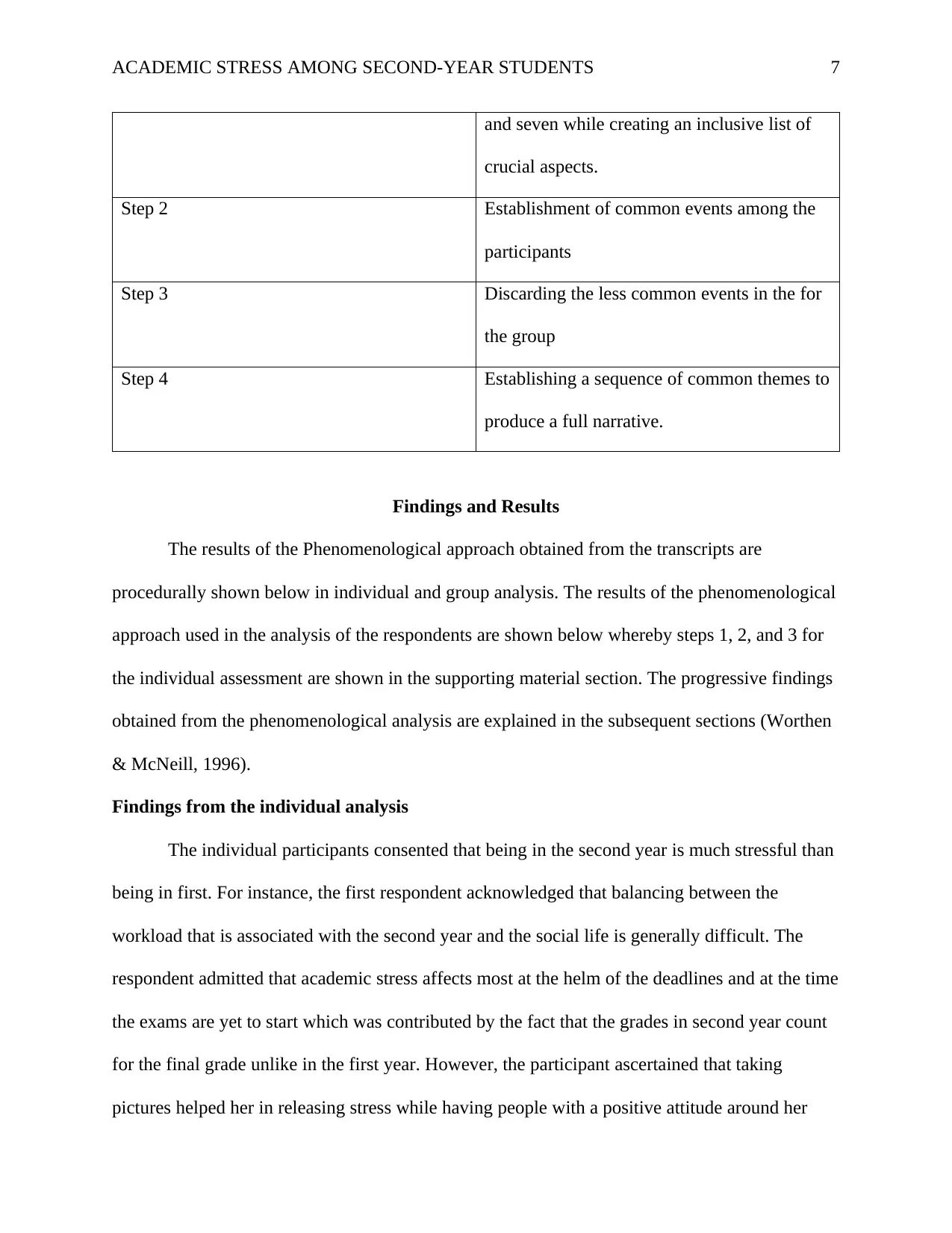
ACADEMIC STRESS AMONG SECOND-YEAR STUDENTS 7
and seven while creating an inclusive list of
crucial aspects.
Step 2 Establishment of common events among the
participants
Step 3 Discarding the less common events in the for
the group
Step 4 Establishing a sequence of common themes to
produce a full narrative.
Findings and Results
The results of the Phenomenological approach obtained from the transcripts are
procedurally shown below in individual and group analysis. The results of the phenomenological
approach used in the analysis of the respondents are shown below whereby steps 1, 2, and 3 for
the individual assessment are shown in the supporting material section. The progressive findings
obtained from the phenomenological analysis are explained in the subsequent sections (Worthen
& McNeill, 1996).
Findings from the individual analysis
The individual participants consented that being in the second year is much stressful than
being in first. For instance, the first respondent acknowledged that balancing between the
workload that is associated with the second year and the social life is generally difficult. The
respondent admitted that academic stress affects most at the helm of the deadlines and at the time
the exams are yet to start which was contributed by the fact that the grades in second year count
for the final grade unlike in the first year. However, the participant ascertained that taking
pictures helped her in releasing stress while having people with a positive attitude around her
and seven while creating an inclusive list of
crucial aspects.
Step 2 Establishment of common events among the
participants
Step 3 Discarding the less common events in the for
the group
Step 4 Establishing a sequence of common themes to
produce a full narrative.
Findings and Results
The results of the Phenomenological approach obtained from the transcripts are
procedurally shown below in individual and group analysis. The results of the phenomenological
approach used in the analysis of the respondents are shown below whereby steps 1, 2, and 3 for
the individual assessment are shown in the supporting material section. The progressive findings
obtained from the phenomenological analysis are explained in the subsequent sections (Worthen
& McNeill, 1996).
Findings from the individual analysis
The individual participants consented that being in the second year is much stressful than
being in first. For instance, the first respondent acknowledged that balancing between the
workload that is associated with the second year and the social life is generally difficult. The
respondent admitted that academic stress affects most at the helm of the deadlines and at the time
the exams are yet to start which was contributed by the fact that the grades in second year count
for the final grade unlike in the first year. However, the participant ascertained that taking
pictures helped her in releasing stress while having people with a positive attitude around her
Paraphrase This Document
Need a fresh take? Get an instant paraphrase of this document with our AI Paraphraser
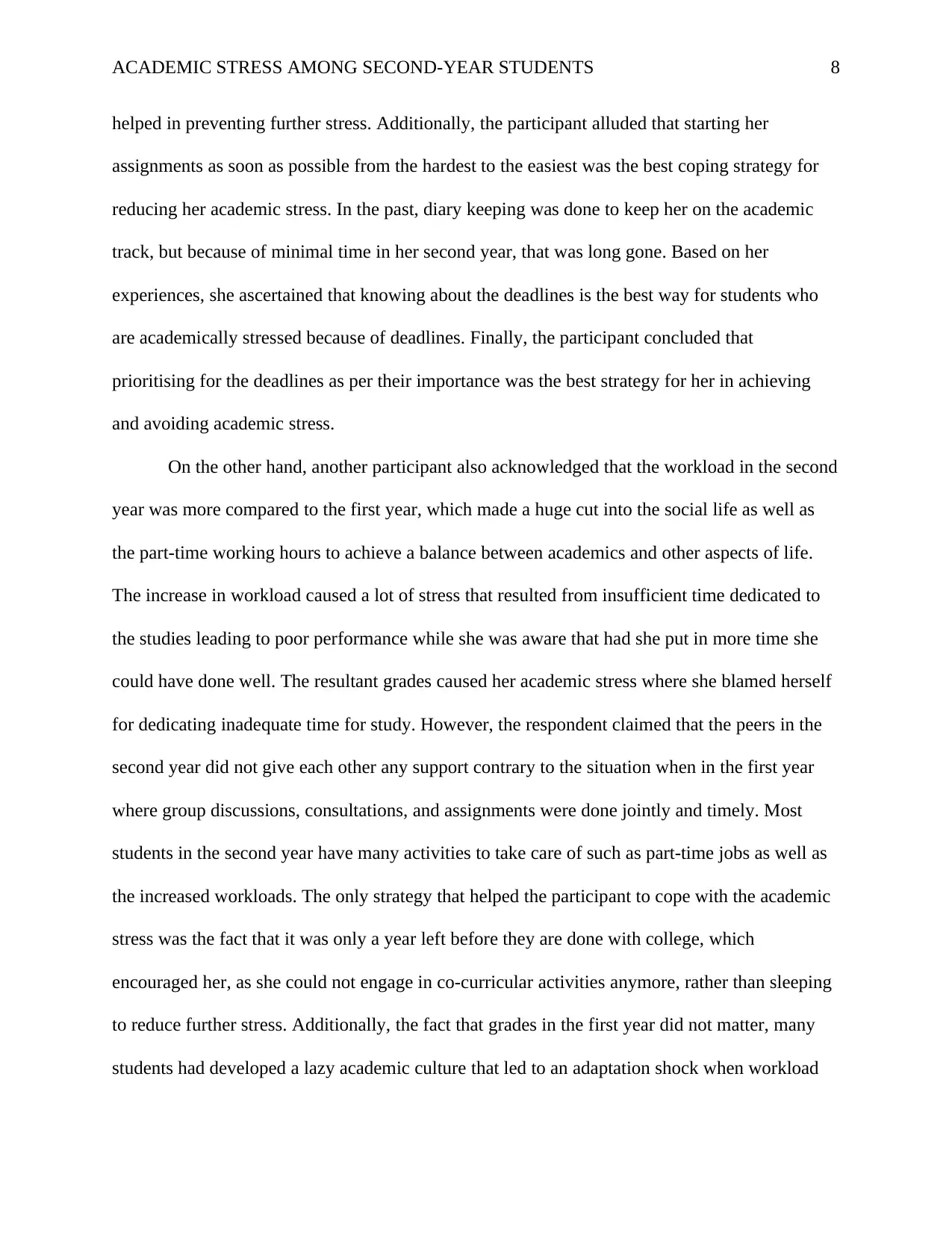
ACADEMIC STRESS AMONG SECOND-YEAR STUDENTS 8
helped in preventing further stress. Additionally, the participant alluded that starting her
assignments as soon as possible from the hardest to the easiest was the best coping strategy for
reducing her academic stress. In the past, diary keeping was done to keep her on the academic
track, but because of minimal time in her second year, that was long gone. Based on her
experiences, she ascertained that knowing about the deadlines is the best way for students who
are academically stressed because of deadlines. Finally, the participant concluded that
prioritising for the deadlines as per their importance was the best strategy for her in achieving
and avoiding academic stress.
On the other hand, another participant also acknowledged that the workload in the second
year was more compared to the first year, which made a huge cut into the social life as well as
the part-time working hours to achieve a balance between academics and other aspects of life.
The increase in workload caused a lot of stress that resulted from insufficient time dedicated to
the studies leading to poor performance while she was aware that had she put in more time she
could have done well. The resultant grades caused her academic stress where she blamed herself
for dedicating inadequate time for study. However, the respondent claimed that the peers in the
second year did not give each other any support contrary to the situation when in the first year
where group discussions, consultations, and assignments were done jointly and timely. Most
students in the second year have many activities to take care of such as part-time jobs as well as
the increased workloads. The only strategy that helped the participant to cope with the academic
stress was the fact that it was only a year left before they are done with college, which
encouraged her, as she could not engage in co-curricular activities anymore, rather than sleeping
to reduce further stress. Additionally, the fact that grades in the first year did not matter, many
students had developed a lazy academic culture that led to an adaptation shock when workload
helped in preventing further stress. Additionally, the participant alluded that starting her
assignments as soon as possible from the hardest to the easiest was the best coping strategy for
reducing her academic stress. In the past, diary keeping was done to keep her on the academic
track, but because of minimal time in her second year, that was long gone. Based on her
experiences, she ascertained that knowing about the deadlines is the best way for students who
are academically stressed because of deadlines. Finally, the participant concluded that
prioritising for the deadlines as per their importance was the best strategy for her in achieving
and avoiding academic stress.
On the other hand, another participant also acknowledged that the workload in the second
year was more compared to the first year, which made a huge cut into the social life as well as
the part-time working hours to achieve a balance between academics and other aspects of life.
The increase in workload caused a lot of stress that resulted from insufficient time dedicated to
the studies leading to poor performance while she was aware that had she put in more time she
could have done well. The resultant grades caused her academic stress where she blamed herself
for dedicating inadequate time for study. However, the respondent claimed that the peers in the
second year did not give each other any support contrary to the situation when in the first year
where group discussions, consultations, and assignments were done jointly and timely. Most
students in the second year have many activities to take care of such as part-time jobs as well as
the increased workloads. The only strategy that helped the participant to cope with the academic
stress was the fact that it was only a year left before they are done with college, which
encouraged her, as she could not engage in co-curricular activities anymore, rather than sleeping
to reduce further stress. Additionally, the fact that grades in the first year did not matter, many
students had developed a lazy academic culture that led to an adaptation shock when workload
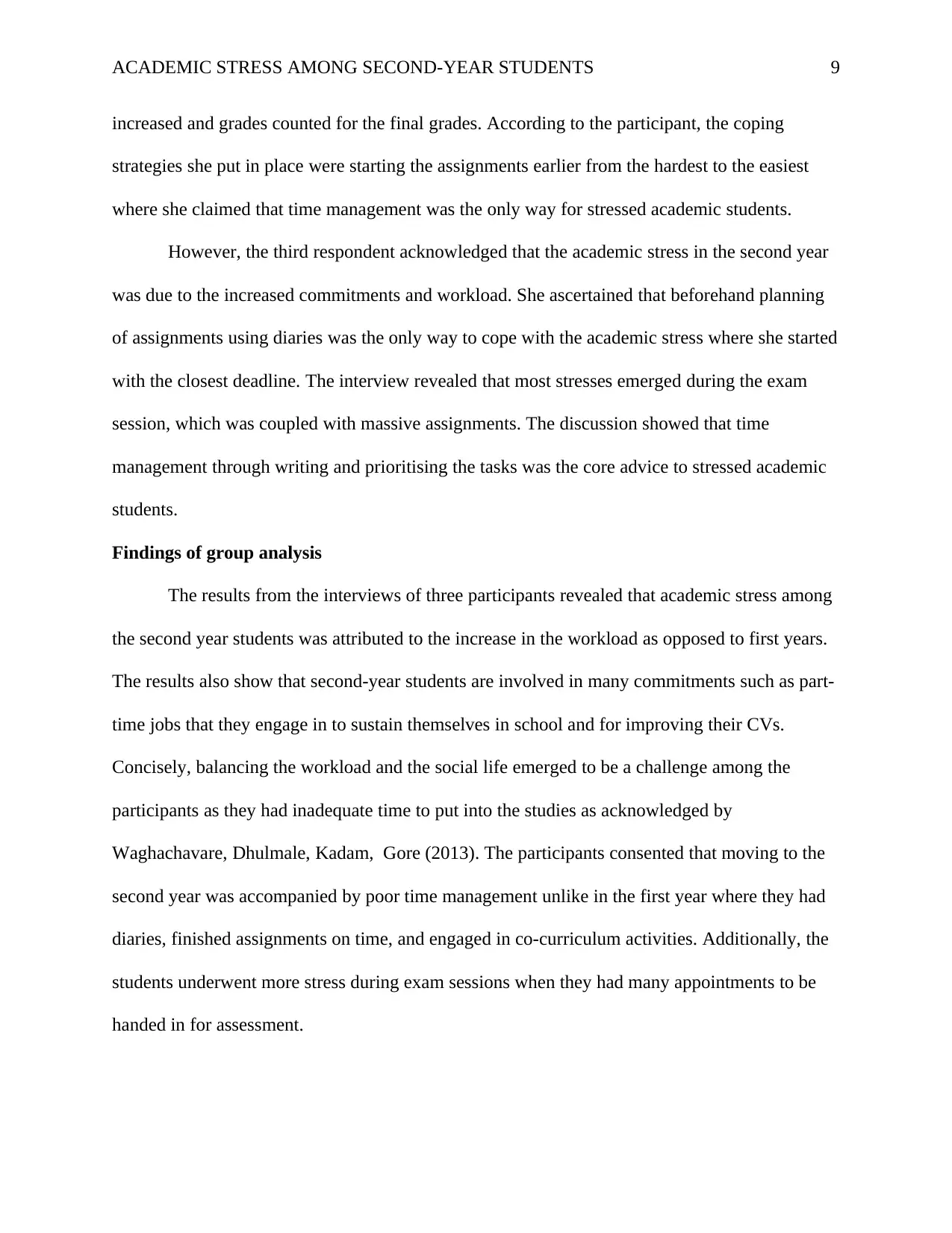
ACADEMIC STRESS AMONG SECOND-YEAR STUDENTS 9
increased and grades counted for the final grades. According to the participant, the coping
strategies she put in place were starting the assignments earlier from the hardest to the easiest
where she claimed that time management was the only way for stressed academic students.
However, the third respondent acknowledged that the academic stress in the second year
was due to the increased commitments and workload. She ascertained that beforehand planning
of assignments using diaries was the only way to cope with the academic stress where she started
with the closest deadline. The interview revealed that most stresses emerged during the exam
session, which was coupled with massive assignments. The discussion showed that time
management through writing and prioritising the tasks was the core advice to stressed academic
students.
Findings of group analysis
The results from the interviews of three participants revealed that academic stress among
the second year students was attributed to the increase in the workload as opposed to first years.
The results also show that second-year students are involved in many commitments such as part-
time jobs that they engage in to sustain themselves in school and for improving their CVs.
Concisely, balancing the workload and the social life emerged to be a challenge among the
participants as they had inadequate time to put into the studies as acknowledged by
Waghachavare, Dhulmale, Kadam, Gore (2013). The participants consented that moving to the
second year was accompanied by poor time management unlike in the first year where they had
diaries, finished assignments on time, and engaged in co-curriculum activities. Additionally, the
students underwent more stress during exam sessions when they had many appointments to be
handed in for assessment.
increased and grades counted for the final grades. According to the participant, the coping
strategies she put in place were starting the assignments earlier from the hardest to the easiest
where she claimed that time management was the only way for stressed academic students.
However, the third respondent acknowledged that the academic stress in the second year
was due to the increased commitments and workload. She ascertained that beforehand planning
of assignments using diaries was the only way to cope with the academic stress where she started
with the closest deadline. The interview revealed that most stresses emerged during the exam
session, which was coupled with massive assignments. The discussion showed that time
management through writing and prioritising the tasks was the core advice to stressed academic
students.
Findings of group analysis
The results from the interviews of three participants revealed that academic stress among
the second year students was attributed to the increase in the workload as opposed to first years.
The results also show that second-year students are involved in many commitments such as part-
time jobs that they engage in to sustain themselves in school and for improving their CVs.
Concisely, balancing the workload and the social life emerged to be a challenge among the
participants as they had inadequate time to put into the studies as acknowledged by
Waghachavare, Dhulmale, Kadam, Gore (2013). The participants consented that moving to the
second year was accompanied by poor time management unlike in the first year where they had
diaries, finished assignments on time, and engaged in co-curriculum activities. Additionally, the
students underwent more stress during exam sessions when they had many appointments to be
handed in for assessment.
⊘ This is a preview!⊘
Do you want full access?
Subscribe today to unlock all pages.

Trusted by 1+ million students worldwide
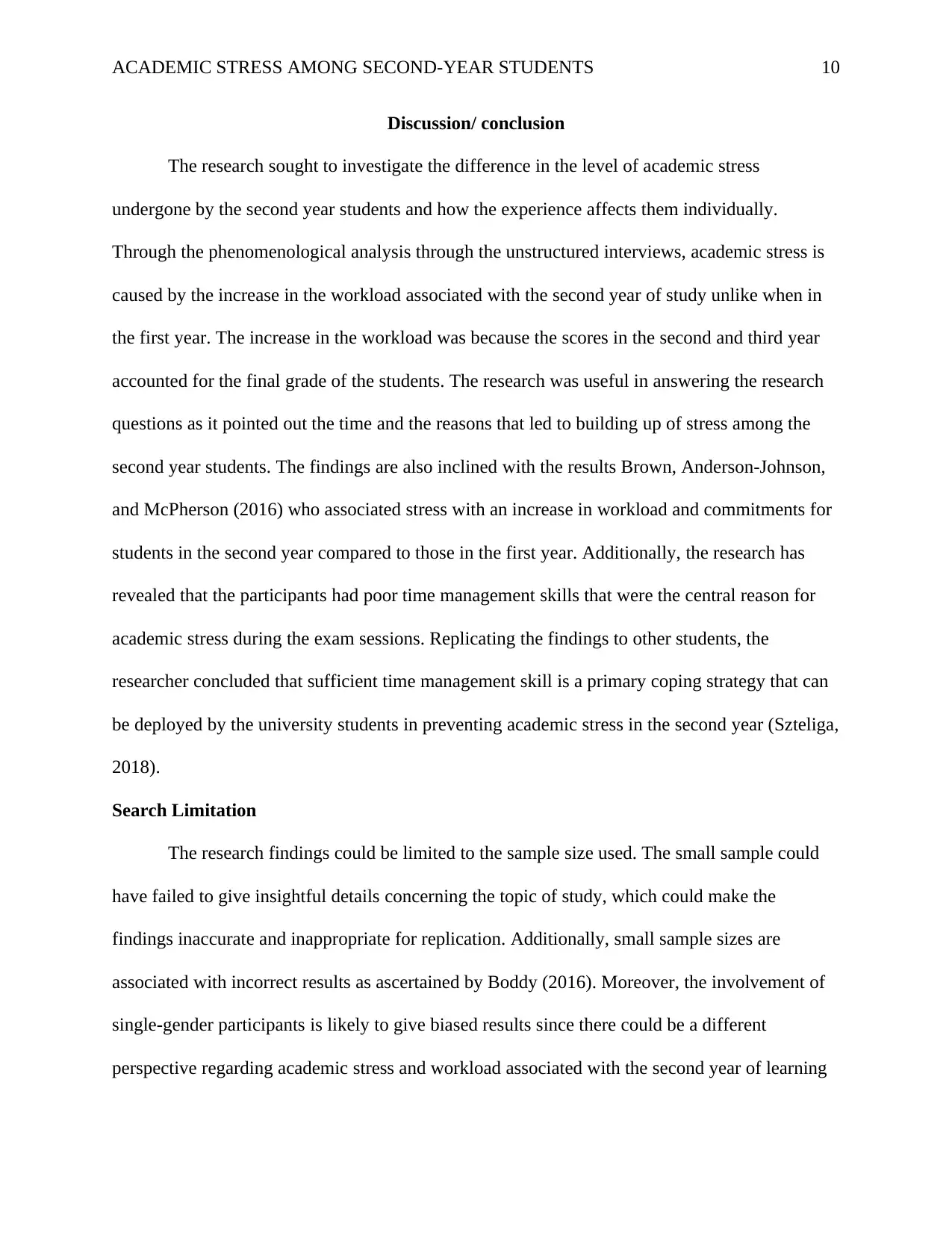
ACADEMIC STRESS AMONG SECOND-YEAR STUDENTS 10
Discussion/ conclusion
The research sought to investigate the difference in the level of academic stress
undergone by the second year students and how the experience affects them individually.
Through the phenomenological analysis through the unstructured interviews, academic stress is
caused by the increase in the workload associated with the second year of study unlike when in
the first year. The increase in the workload was because the scores in the second and third year
accounted for the final grade of the students. The research was useful in answering the research
questions as it pointed out the time and the reasons that led to building up of stress among the
second year students. The findings are also inclined with the results Brown, Anderson-Johnson,
and McPherson (2016) who associated stress with an increase in workload and commitments for
students in the second year compared to those in the first year. Additionally, the research has
revealed that the participants had poor time management skills that were the central reason for
academic stress during the exam sessions. Replicating the findings to other students, the
researcher concluded that sufficient time management skill is a primary coping strategy that can
be deployed by the university students in preventing academic stress in the second year (Szteliga,
2018).
Search Limitation
The research findings could be limited to the sample size used. The small sample could
have failed to give insightful details concerning the topic of study, which could make the
findings inaccurate and inappropriate for replication. Additionally, small sample sizes are
associated with incorrect results as ascertained by Boddy (2016). Moreover, the involvement of
single-gender participants is likely to give biased results since there could be a different
perspective regarding academic stress and workload associated with the second year of learning
Discussion/ conclusion
The research sought to investigate the difference in the level of academic stress
undergone by the second year students and how the experience affects them individually.
Through the phenomenological analysis through the unstructured interviews, academic stress is
caused by the increase in the workload associated with the second year of study unlike when in
the first year. The increase in the workload was because the scores in the second and third year
accounted for the final grade of the students. The research was useful in answering the research
questions as it pointed out the time and the reasons that led to building up of stress among the
second year students. The findings are also inclined with the results Brown, Anderson-Johnson,
and McPherson (2016) who associated stress with an increase in workload and commitments for
students in the second year compared to those in the first year. Additionally, the research has
revealed that the participants had poor time management skills that were the central reason for
academic stress during the exam sessions. Replicating the findings to other students, the
researcher concluded that sufficient time management skill is a primary coping strategy that can
be deployed by the university students in preventing academic stress in the second year (Szteliga,
2018).
Search Limitation
The research findings could be limited to the sample size used. The small sample could
have failed to give insightful details concerning the topic of study, which could make the
findings inaccurate and inappropriate for replication. Additionally, small sample sizes are
associated with incorrect results as ascertained by Boddy (2016). Moreover, the involvement of
single-gender participants is likely to give biased results since there could be a different
perspective regarding academic stress and workload associated with the second year of learning
Paraphrase This Document
Need a fresh take? Get an instant paraphrase of this document with our AI Paraphraser
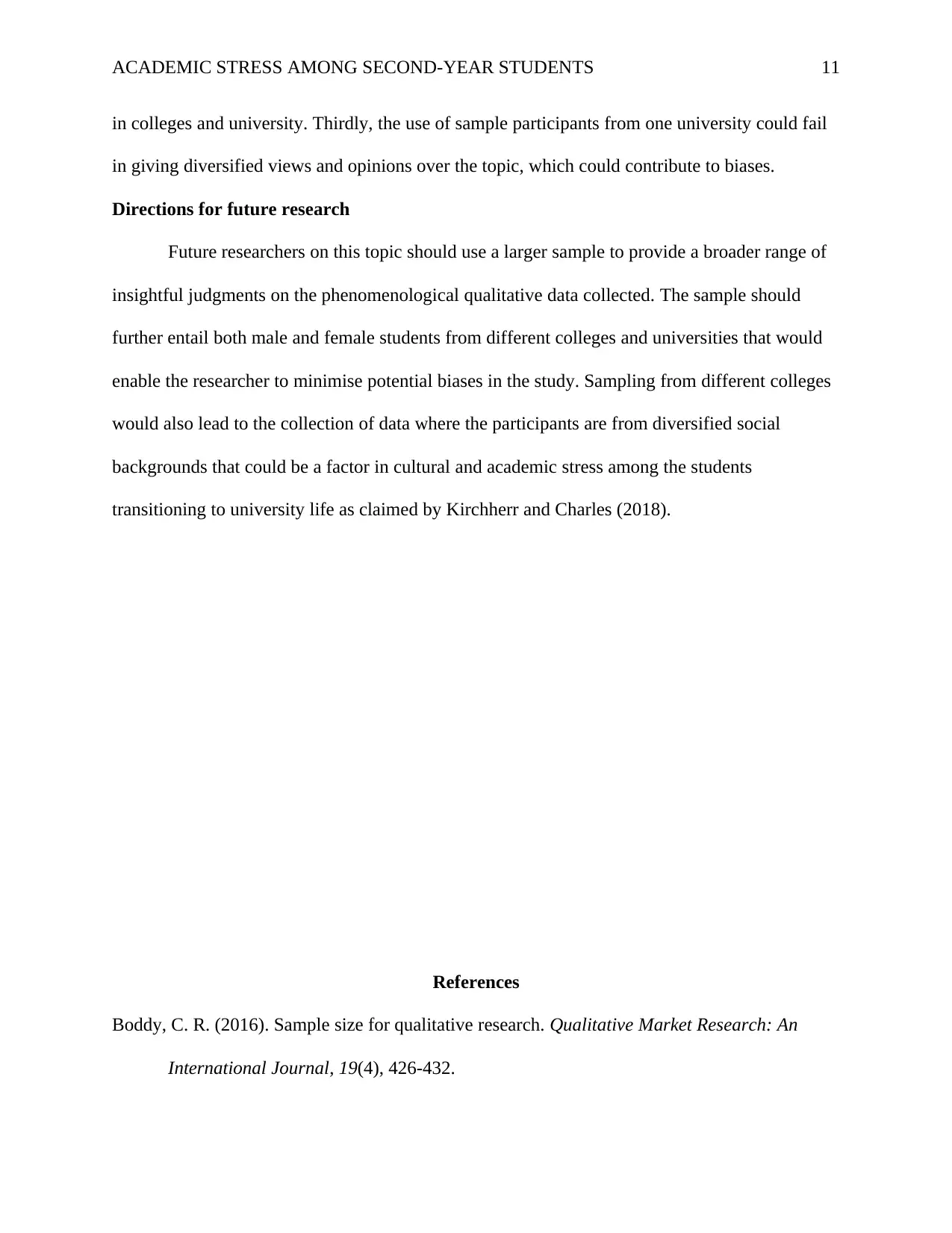
ACADEMIC STRESS AMONG SECOND-YEAR STUDENTS 11
in colleges and university. Thirdly, the use of sample participants from one university could fail
in giving diversified views and opinions over the topic, which could contribute to biases.
Directions for future research
Future researchers on this topic should use a larger sample to provide a broader range of
insightful judgments on the phenomenological qualitative data collected. The sample should
further entail both male and female students from different colleges and universities that would
enable the researcher to minimise potential biases in the study. Sampling from different colleges
would also lead to the collection of data where the participants are from diversified social
backgrounds that could be a factor in cultural and academic stress among the students
transitioning to university life as claimed by Kirchherr and Charles (2018).
References
Boddy, C. R. (2016). Sample size for qualitative research. Qualitative Market Research: An
International Journal, 19(4), 426-432.
in colleges and university. Thirdly, the use of sample participants from one university could fail
in giving diversified views and opinions over the topic, which could contribute to biases.
Directions for future research
Future researchers on this topic should use a larger sample to provide a broader range of
insightful judgments on the phenomenological qualitative data collected. The sample should
further entail both male and female students from different colleges and universities that would
enable the researcher to minimise potential biases in the study. Sampling from different colleges
would also lead to the collection of data where the participants are from diversified social
backgrounds that could be a factor in cultural and academic stress among the students
transitioning to university life as claimed by Kirchherr and Charles (2018).
References
Boddy, C. R. (2016). Sample size for qualitative research. Qualitative Market Research: An
International Journal, 19(4), 426-432.
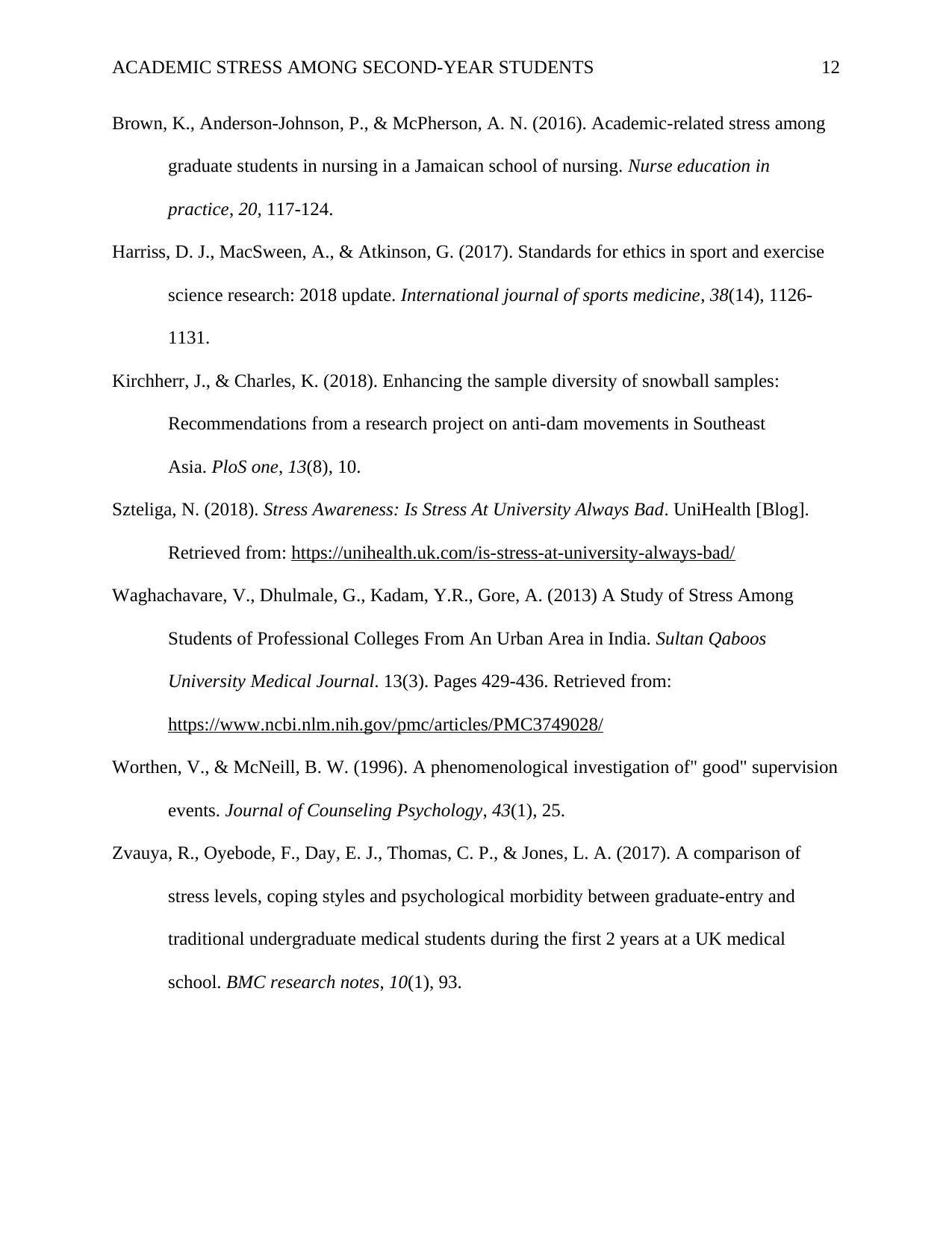
ACADEMIC STRESS AMONG SECOND-YEAR STUDENTS 12
Brown, K., Anderson-Johnson, P., & McPherson, A. N. (2016). Academic-related stress among
graduate students in nursing in a Jamaican school of nursing. Nurse education in
practice, 20, 117-124.
Harriss, D. J., MacSween, A., & Atkinson, G. (2017). Standards for ethics in sport and exercise
science research: 2018 update. International journal of sports medicine, 38(14), 1126-
1131.
Kirchherr, J., & Charles, K. (2018). Enhancing the sample diversity of snowball samples:
Recommendations from a research project on anti-dam movements in Southeast
Asia. PloS one, 13(8), 10.
Szteliga, N. (2018). Stress Awareness: Is Stress At University Always Bad. UniHealth [Blog].
Retrieved from: https://unihealth.uk.com/is-stress-at-university-always-bad/
Waghachavare, V., Dhulmale, G., Kadam, Y.R., Gore, A. (2013) A Study of Stress Among
Students of Professional Colleges From An Urban Area in India. Sultan Qaboos
University Medical Journal. 13(3). Pages 429-436. Retrieved from:
https://www.ncbi.nlm.nih.gov/pmc/articles/PMC3749028/
Worthen, V., & McNeill, B. W. (1996). A phenomenological investigation of" good" supervision
events. Journal of Counseling Psychology, 43(1), 25.
Zvauya, R., Oyebode, F., Day, E. J., Thomas, C. P., & Jones, L. A. (2017). A comparison of
stress levels, coping styles and psychological morbidity between graduate-entry and
traditional undergraduate medical students during the first 2 years at a UK medical
school. BMC research notes, 10(1), 93.
Brown, K., Anderson-Johnson, P., & McPherson, A. N. (2016). Academic-related stress among
graduate students in nursing in a Jamaican school of nursing. Nurse education in
practice, 20, 117-124.
Harriss, D. J., MacSween, A., & Atkinson, G. (2017). Standards for ethics in sport and exercise
science research: 2018 update. International journal of sports medicine, 38(14), 1126-
1131.
Kirchherr, J., & Charles, K. (2018). Enhancing the sample diversity of snowball samples:
Recommendations from a research project on anti-dam movements in Southeast
Asia. PloS one, 13(8), 10.
Szteliga, N. (2018). Stress Awareness: Is Stress At University Always Bad. UniHealth [Blog].
Retrieved from: https://unihealth.uk.com/is-stress-at-university-always-bad/
Waghachavare, V., Dhulmale, G., Kadam, Y.R., Gore, A. (2013) A Study of Stress Among
Students of Professional Colleges From An Urban Area in India. Sultan Qaboos
University Medical Journal. 13(3). Pages 429-436. Retrieved from:
https://www.ncbi.nlm.nih.gov/pmc/articles/PMC3749028/
Worthen, V., & McNeill, B. W. (1996). A phenomenological investigation of" good" supervision
events. Journal of Counseling Psychology, 43(1), 25.
Zvauya, R., Oyebode, F., Day, E. J., Thomas, C. P., & Jones, L. A. (2017). A comparison of
stress levels, coping styles and psychological morbidity between graduate-entry and
traditional undergraduate medical students during the first 2 years at a UK medical
school. BMC research notes, 10(1), 93.
⊘ This is a preview!⊘
Do you want full access?
Subscribe today to unlock all pages.

Trusted by 1+ million students worldwide
1 out of 24
Related Documents
Your All-in-One AI-Powered Toolkit for Academic Success.
+13062052269
info@desklib.com
Available 24*7 on WhatsApp / Email
![[object Object]](/_next/static/media/star-bottom.7253800d.svg)
Unlock your academic potential
Copyright © 2020–2025 A2Z Services. All Rights Reserved. Developed and managed by ZUCOL.





